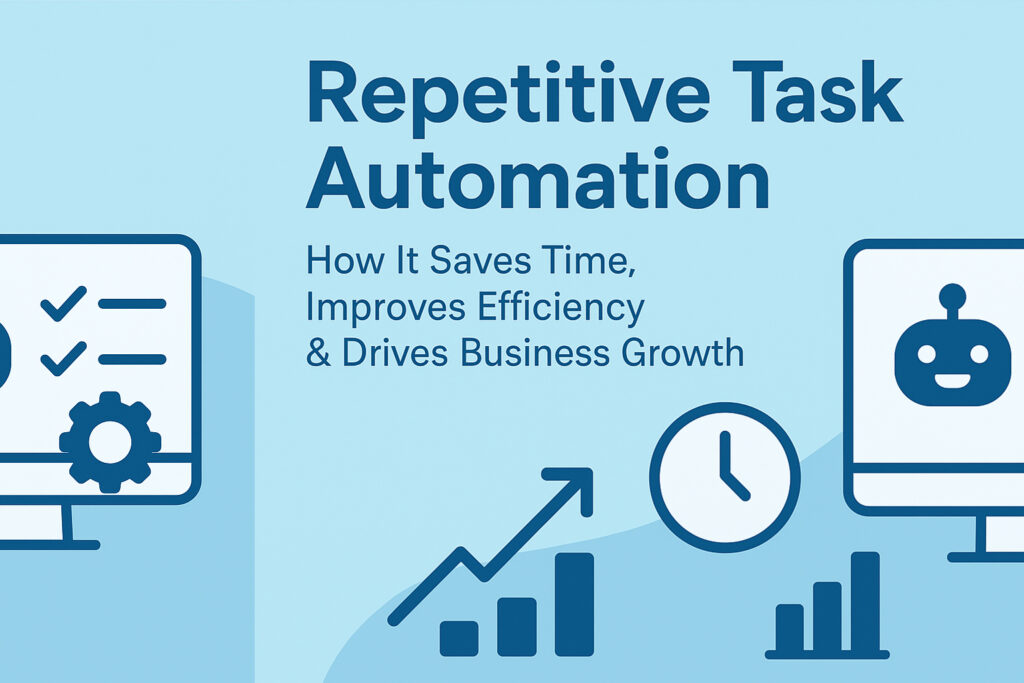Why Repetitive Task Automation is Essential for Business Growth
Introduction
In today’s fast-paced digital world, businesses are under constant pressure to do more with less. Employees spend countless hours on repetitive tasks that often drain productivity and reduce focus on meaningful work. Repetitive task automation has emerged as a game-changing solution that not only saves time but also improves efficiency, reduces errors, and fuels overall business growth.
This blog explores why automation is no longer optional—it’s essential for success. Let’s dive deep into how businesses can transform their operations by automating repetitive processes.
1. What is Repetitive Task Automation?
Repetitive task automation refers to the use of technology, software, or AI tools to perform routine tasks that employees traditionally handle. These tasks may include data entry, scheduling, report generation, responding to customer queries, or managing workflows.
Instead of wasting valuable time, businesses can delegate such activities to automated systems, freeing up employees to focus on higher-value work.
2. How Automation Saves Time
Time is one of the most valuable resources for any business. By automating repetitive tasks, companies can reclaim hours that would otherwise be lost to manual labor.
Example: Instead of spending hours entering invoices, an automation tool can complete the same work in minutes.
Impact: Employees can use the saved time for customer engagement, strategy planning, or creative projects.
Simply put, automation allows businesses to achieve more in less time.
3. Reducing Errors Through Automation
Human error is inevitable, especially when tasks are repetitive and monotonous. A single data-entry mistake or missed email can create huge setbacks. Automation reduces these risks by ensuring accuracy and consistency.
Fewer mistakes in financial records
More accurate reporting
Better compliance with industry regulations
The result is improved trust, reliability, and smoother business operations.
4. Improving Efficiency Across Teams
Automation doesn’t just save time; it makes processes smarter. When routine tasks are handled automatically, workflows become faster and smoother.
Teams experience fewer bottlenecks.
Communication becomes more streamlined.
Resources are allocated more effectively.
An efficient workplace fosters innovation, collaboration, and overall business growth.
5. Driving Business Growth Through Automation
Ultimately, the goal of automation is business growth. By eliminating manual inefficiencies, companies can scale faster, increase revenue, and enhance customer satisfaction.
Small businesses can compete with larger enterprises by automating routine tasks.
Large corporations can maintain consistency and improve customer service across multiple departments.
Automation empowers organizations of all sizes to grow sustainably and strategically.
* Conclusion
Repetitive task automation is no longer a luxury—it’s a necessity for businesses aiming to thrive in today’s competitive market. From saving time and reducing errors to improving efficiency and unlocking new opportunities for business growth, automation transforms the way organizations operate.
Investing in automation today means building a smarter, faster, and more successful business for tomorrow.
Frequently Asked Questions (FAQs)
1. What are some examples of repetitive tasks that can be automated?
Data entry, invoice processing, email responses, scheduling, social media posting, and reporting are common tasks businesses automate.
2. How does automation help save time in a business?
Automation handles tasks in minutes that might take employees hours, freeing them to focus on higher-value work.
3. Can small businesses benefit from repetitive task automation?
Yes, small businesses can save time, reduce costs, and compete effectively with larger competitors by automating routine processes.
4. Does automation completely replace human employees?
No. Automation supports employees by handling repetitive work, allowing them to focus on creativity, strategy, and customer relationships.
5. What technologies are used for task automation?
AI-powered software, workflow automation tools, robotic process automation (RPA), and project management systems are commonly used.
6. How does automation reduce errors in business operations?
Unlike humans, automation follows programmed instructions consistently, ensuring accuracy in data and processes.
7. Is automation costly to implement?
The cost depends on the tools and scale, but in the long run, automation often saves businesses money by improving efficiency and reducing manual labor.
